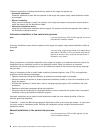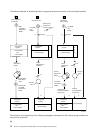v Place your job in a premastering state. When the job is in this state, all save operations (SAVOBJ,
SAVLIB, SAVLICPGM, SAV, etc.) result in information being stored about the sizes of these tape files.
This information is then used by the Generate CD-ROM Premastering Information
(qlpGenCdPremasteringInfo) API to generate the QDSETMAP bytestream file. Also, while in this state,
the data format that is written to tape is changed slightly so it can be restored from the CD-ROM.
v Query the existing state of your job as well as optionally getting information about saves that may have
already taken place. In case you are interrupted, this lets you know where you have left off and where
to restart. As input to the qlpHandleCdState API you need to specify a distribution set map identifier.
This identifier is used to ensure that correct information is returned about the saved files.
v Take your job out of a premastering state.
Note: Ending your job also takes your job out of a premastering
state.
The qlpGenCdPremasteringInfo API allows you to do the following:
v Create a bytestream file in the root directory. This file contains information about which tape files reside
on each CD-ROM volume. The name of the file is /qlpnnnnnnnnnn where nnnnnnnnnn is the name of
the distribution set map identifier provided as an input parameter to this API. For more information, see
Saving the contents of the bytestream file.
The only valid characters for nnnnnnnnnn in the set map identifier are uppercase letters A through Z,
numeric characters 0 through 9, and underscore (_).
v Retrieve information about the files saved when the job was enabled for CD-ROM premastering by
using the qlpHandleCdState API. This information includes:
– The tape file name.
– The corresponding CD-ROM file name.
– The CD-ROM volume it is placed on.
– The volume serial position in this set of CD-ROMs.
Electronic distribution and installation of licensed programs
IBM licensed programs and customer applications can be distributed and installed electronically from a
central site system. There are two options available.
You can use Management Central if you are running on a TCP/IP network instead of a SNA network.
Management Central is a part of Operations Navigator.
You can also use the System Manager/400 licensed program provides centralized services for software
distribution and installation on other systems in SNA and TCP/IP networks. To receive licensed programs
and applications electronically from the central site system, both the central site system and the target site
system must have the latest release level of the Managed System Services/400 licensed program
installed.
Note: The Managed System Services/400 licensed program
cannot be installed remotely on the target site system
from the central site system.
The benefits in using electronic distribution from the central site system are:
v Fewer errors because distribution and installation plans can be created, reviewed, and tested before
sending updates to the managed system sites.
v Reduced operation costs because the central site system tracks job status.
Installation methods
Using central site distribution to install multiple iSeries servers 7


















